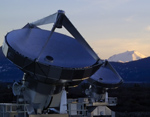Radio Astronomy Laboratory
The Radio Astronomy Laboratory (RAL) was created in 1958 to foster research in radio astronomy, a discipline that naturally extends beyond the borders of traditional academic departments at Berkeley. Over the years, faculty and graduate students from the Astronomy, Physics, Chemistry, Electrical Engineering and Computer Science, and Earth and Planetary Science departments have made use of the RAL's facilities and resources.
The RAL leverages cutting-edge work in electronics, digital signal-processing instrumentation, and electromagnetic design to develop experiments and observatories that facilitate the exploration and understanding of our universe. RAL-involved facilities have included the Hat Creek Observatory, the Berkeley-Maryland-Illinois Array (BIMA), the Allen Telescope Array (ATA), the Combined Array for Research in Millimeter-wave Astronomy (CARMA), the Precision Array for Probing the Epoch of Reionization (PAPER), the Hydrogen Epoch of Reionization Array (HERA), the South Pole Telescope (SPT), and the Simons Observatory (SO). Current RAL research spans the measurement of primordial inflation in the polarization of the cosmic microwave background, the exploration of the cosmic dawn and reionization of the universe, the measurement of gravitational-wave background through pulsar timing, the direct imaging of black holes, the detection of fast radio bursts from galactic magnetars, and the search for bio- and techno-signatures from extraterrestrial life.

The Radio Astronomy Laboratory at UC Berkeley has been one of the most important centers in the world producing new generations of radio astronomers and instrumentalists. Through the Collaboration for Astronomy Signal Processing and Electronics Research (CASPER), the RAL has also spurred the development of novel instrumentation world-wide through open-source hardware and digital-signal processing algorithms targeting high-bandwidth and large-N scalability. Researchers at the RAL also play an active role in characterizing and preserving the terrestrial radio spectrum for current and future astronomical science.
